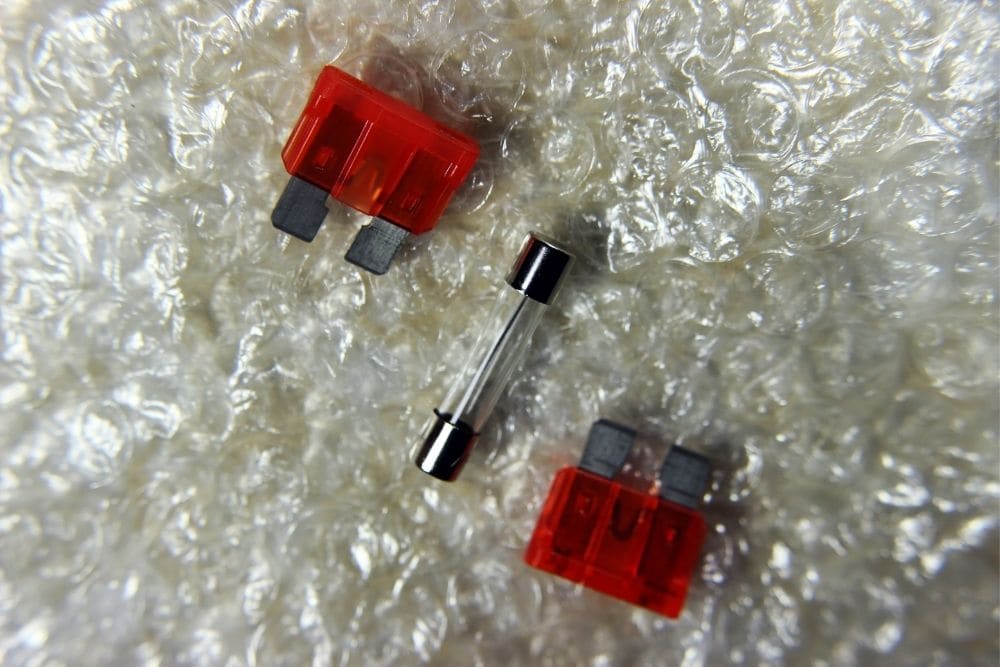Fuses and circuit breakers play an important role in all electrical systems, including your trolling motor.
If you’re new to trolling motors, you may not understand what fuses and circuit breakers are and why they’re important.
This post will compare the differences between fuses and circuit breakers and which one is right for you.
Table of Contents
Trolling Motor Fuse vs. Circuit Breaker (How It Works)
Circuit breakers and fuses achieve the same result by working in completely different ways.
Both are designed to protect the inner electrical systems of your trolling motor, including your battery, from damages caused by short circuits and electrical current overload.
Circuit breakers will cut power or “trip” above a certain amperage, so the battery and motor don’t experience electrical overload.
The metal strip in the breaker will flex due to the heat caused by the extra current.
When the breaker flexes, the switch is tripped, and the flow of current stops.
As a result, the motor will prevent itself from overloading and causing severe damages.
A circuit breaker uses a bi-metal strip or an electromagnet to offer better circuit protection.
The magnetic force of the bi-metal strip increases when there is an electric current that passes through the circuit.
Even when the connection is broken, the circuit breaker won’t get damaged, unlike the fuse.
You simply have to fix the electrical fault and then turn the circuit breaker back on and reconnect the circuit.
On the other hand, when extra current flows through the electrical system, the fuse will heat up. Once the conductor reaches a melting point, the fuse will blow up.
Why It’s Important

Circuit breakers act as an insurance policy for protecting your new motor.
If the prop of your trolling motor gets caught in any underwater objects such as thick weeds, logs, or rocks, your motor will respond by drawing extra power from the battery source to turn the shaft.
However, the longer this occurs, the more likely, the higher the current level can permanently damage your trolling motor.
They safeguard the inner electrical system of your trolling motor. Motors are prone to get overloaded and may receive severe damages from short circuits.
When your motor experiences a short circuit or gets overloaded, the circuit breaker acts as a protection because it receives this charge of electrical current first.
As a result, the motor will get turned off, or it will trip. Without having a circuit breaker installed, your motor will receive damages in many of its critical parts.
Beyond external factors, the circuit inside of a motor can experience resistance from other factors such as:
- The diameter of the wire is incorrect
- A long wire runs through the power source
- There could be loose or corroded connections inside of the electrical circuit
Ideally, you’ll want to choose a circuit breaker that is slightly above the amperage draw that your motor offers at its maximum speed.
Using a Fuse for Trolling Motors
There are some advantages of using a fuse instead of a circuit breaker for your trolling motor.
The size of the fuse is much smaller, more affordable, and has a higher breaking capacity. In contrast, a circuit breaker may have a low breaking capacity and is much more expensive.
Unfortunately, there are risks in using a fuse rather than a circuit breaker for protecting short circuits.
These two aren’t interchangeable. Using a fuse means an extra current flows through the circuit, which results in potentially overheating.
If the conductor reaches a melting point, the fuse will blow out, and the entire circuit is broken.
Fuse works by depending on heat accumulation to provide protection. But if it overheats, you’ll need to replace your blown-out fuse with a new one.

The downside of using a fuse is that it only provides circuit protection once.
In addition, replacing it can be extremely inconvenient; therefore, you should always keep a few replacement fuses in your inflatable boat.
Use Cases
Installing a fuse or circuit breaker can be quite complicated. Consider hiring a marine technician to help install your fuse or circuit breaker if it’s your first time.
Circuit breakers are available in many types of amperages. Select the circuit breaker with a capacity based on the maximum electrical current your motor can draw at its maximum speed.
For example, an amper that can draw up to 42 amperes will require a 50 amp circuit breaker. And an amper that draws between 43 to 56 amperes will require a 60 amp circuit breaker.
Safety
For safety, it’s better to use a circuit breaker. Since fuses only work for single-use, you’ll need to replace it every time it blows.

This could happen once or many times throughout your trip. However, circuit breakers can be used repeatedly over and over by simply pushing the reset button.
Also, fuses can represent a safety risk for unskilled individuals. Since the conductors are exposed, there is always the danger of electric shock or electrocution.
With circuit breakers, the operations can be performed remotely, and the connections are hidden behind the device.
This makes it much safer, especially for unskilled people. On the other hand, using a fuse with the wrong rating or model can cause fire and damage your motor.
Affordability

Since trolling motors typically don’t include fuses or circuit breakers, you’ll need to purchase them separately.
Fuses are much more affordable than circuit breakers. They may come in a huge assortment of packs of 10 to 250 pieces of marine fuses and cost a fraction of electrical circuit breakers.
However, it’s a hassle to continuously replace the fuse every time you’re in the water.
Performance

Unfortunately, fuses can be degraded over time due to aging, which can cause them to open.
And there isn’t a way to test the fuse, meaning you won’t know the current value that may cause the fuse to open.
During manufacturing, circuit breakers are thoroughly tested and can be retested during it’s operating life. This means performance is more consistent and can be maintained.
Extended Protection
When it comes to overload conditions, circuit breakers can trip up to a thousand times faster than fuses can.
The breaking capacity is also much higher than fuses, which is up to 150 kA.
Circuit breakers also can provide fault current limitation, which helps to extend its service life and reduce asset aging.
This means that it can limit the amount of current flowing through the electrical system enabling uninterrupted and continual operation.
Fuses take more time since you have to replace them once they break. Circuit breakers help to minimize downtime and quickly reconnect the circuit break.
Final Verdict: Which is Better?
It’s clear after comparing the safety, affordability, performance, and protection between the two, we’ve determined circuit breakers are certainly the better option.
The ease of use and remote access gives even inexperienced boaters the ability to protect the inner circuitry of their trolling motor.

I created this site to help people – to help you – with your boat problems. Instead of helping one person at a time, I want this website to be the “one-stop-shop” for everyone’s boating concerns. Read more.



